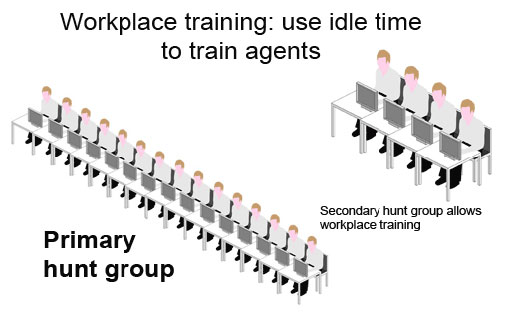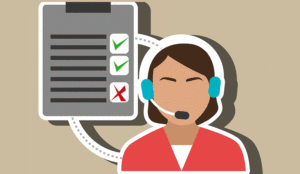Graham Chick argues that using quiet periods for on-the-job training, coupled with the use of new technology, can help to keep agents updated and improve performance.
This is probably one of the more emotive subjects in any organisation, let alone within contact / call centre operators.
Here, it would appear, any number of “training gurus” offer their own methodology and advice that guarantee to achieve best results!
However, when faced with ever increasing demands for contact centre profitability (and thus agent efficiency), releasing even a limited number of agents to undertake training programmes is a major challenge.
So let’s explore, for a moment, how combining technology and on-the-job personal training saves both time and money.
The secret ingredient?
Why not actually train agents using the technology that they require training on?
Widely quoted statistics estimate that people remember 20% of what they hear and 30% of what they see. Combine seeing and hearing and it rises to 50%. Get people ‘doing’ and retention of information shoots up to 70% and beyond. Whether you credit these figures, it is indisputable that people learn more when they are actually participating in the activity which they are trying to learn!
Learning on the job

Laurie Dobson
My recent discussions with Laurie Dobson, CEO of ISV Software, support this theory. ISV has been providing online pre-employment testing and e-learning to the call centre industry since 1992. He agrees with me that enabling agents to spend some personal quality time, during the working day, learning what they need to learn “on the job” is far more beneficial and cost effective.
Experience supports the research quoted above that there is far greater retention of information gleaned this way.
As Laurie explained to me, “We have long recognised that conventional assessment and training takes time, and time costs money. By working with call centre managers, we found ways of developing training that can be delivered in the workplace using “idle time”. In an inbound call centre, calls will fluctuate over a period of time. Sometimes your call centre will be very busy and sometimes less so.
Spare idle time
Why not exploit this spare idle time and make use of it as free training time? This can be achieved very simply. ISV recommends that you set up primary hunt groups on your ACD to take calls within your call centre. 90–95% of your staff work in these primary hunt groups. This leaves between 5 and 10% of your staff who you can place into secondary hunt groups. You can feed calls through to these people when everybody in the primary hunt groups is busy. However, the secondary hunt group will get long periods of time when they are not receiving calls. This is where workplace training comes in…”

So, building on this philosophy, I start thinking about how contact centres could further enhance their individual agents’ performance.
What about using live, on-the-call quality monitoring, phrase recognition and speech analytics? Suddenly we’re in interesting territory!
In my recent article entitled “I know what my problems are…but I don’t know how to solve them”, I postulated how the adoption of live, on-the-call, quality monitoring and speech recognition applications can address many problems at source. So issues are pinpointed as they are happening during the actual call in order to achieve “first call resolution”.
Developing this thesis, I would now like to explore how adoption of such technologies could also provide agents with their own, very productive, on-the-job training in order to further enhance their own performance.
Reminding agents of what they need to say
I recently spoke with a call centre manager who was actively considering the deployment of a live, on-the-call quality monitoring and phrase recognition solution. She explained that adoption of such a solution would inevitably allow “…every agent to enjoy the benefit of effectively having their own private mentor and trainer, sitting on their shoulder, all day, every day. It reminds them what they need to say, or picks out what they have forgotten to say, or got wrong, that they were speaking too loud or too soft, too fast or too slow. It flags if they should stop interrupting the caller, or if they need to allow the customer to speak more. All this in order to achieve the ultimate goal within a call centre, first call resolution… and perhaps more importantly, a happy customer each and every call…”
Quality time during the working day
Given this feedback, it became crystal clear to me that combining the technological solution of providing live, on-the-call monitoring and reporting with the philosophy of providing agents with some “quality time” during the working day could deliver some amazing results. During this time the agents could review their own calls – perhaps those made earlier in the day whilst they are still very fresh in their minds.
Playing back the call and studying the results and feedback produced at the time by the call analytics technology could very significantly enhance their understanding. They would clearly see what they were doing right, or wrong, or could do better on the next call.
Such reviews would not only give agents greater confidence by proving to them what they, personally, were doing right, but would also show what they need to work on to improve in other areas.
Agents forgetting to say something
Maybe they are forgetting to, or missing the opportunity to, introduce up-selling opportunities where allowed for in the call scripts. Or perhaps they are learning how they might have delivered the phrase more clearly or concisely…or where they keep on forgetting to say something which is key to achieving a fully compliant call. It would also identify where agents might actually need third-party training in order to reach that next level.
Adoption of such techniques would also be so empowering to the individual agent who is constantly looking to improve their own performance. These are no doubt related to their own key performance indicators (KPIs) which, in turn, probably link directly into their own bonus payments and take-home pay for the month!
Comprehensive statistics
Furthermore – and this is a key point – comprehensive statistics, prepared automatically on a weekly / monthly / quarterly basis could also indicate, on a per agent basis, levels of improvement based upon the number of times they “get it right” by saying all the things that they need to say. Any improvement from any base could be considered acceptable or good.
On the flip side, if the stats show no improvement, worsening performance, identify a deteriorating attitude or possibly other problems, these can be addressed quickly, with the hard evidence available to deal effectively with the problem!
Less than 5% of calls are monitored

Graham Chick
Having said all of this, when considering all the arguments as to whether to adopt enhanced training tools, it is important to remember that at present very, very few contact centres currently monitor more than 5% of all calls. For the vast majority, it is far less than that. This means that a staggering 95% of calls or more go unchecked.
Given the increasing pressure on contact centres to deliver ever greater efficiencies and agent performance, adoption of cost-effective, on-the-job training has got to be explored.
For those operating in sectors facing ever greater demands of increased regulation and increasing fines for non-compliance, it could be a case of can you afford not to!
Graham Chick is Chief Executive of GemaTech Ltd
Author: Jo Robinson
Published On: 1st Aug 2012 - Last modified: 23rd Jun 2017
Read more about - Call Centre Management, GemaTech, ISV Software, Staffing, Training



































